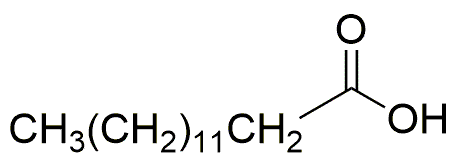Myristic acid is widely utilized in research focused on:
- Cosmetics and Personal Care: Commonly used in formulations for creams and lotions, it acts as an emollient and thickening agent, providing a smooth texture and enhancing skin hydration.
- Food Industry: Employed as a flavoring agent and preservative, myristic acid can enhance the taste and shelf-life of various food products, making it valuable for food manufacturers.
- Pharmaceuticals: Utilized in the production of certain medications, it serves as a surfactant and stabilizer, improving drug delivery and efficacy in formulations.
- Surfactants and Detergents: Myristic acid is a key ingredient in the manufacture of soaps and detergents, providing effective cleaning properties while being gentle on the skin.
- Industrial Applications: Used in the production of lubricants and plasticizers, it enhances the performance of various industrial products, contributing to improved efficiency and longevity.
General Information
Properties
Safety and Regulations
Applications
Myristic acid is widely utilized in research focused on:
- Cosmetics and Personal Care: Commonly used in formulations for creams and lotions, it acts as an emollient and thickening agent, providing a smooth texture and enhancing skin hydration.
- Food Industry: Employed as a flavoring agent and preservative, myristic acid can enhance the taste and shelf-life of various food products, making it valuable for food manufacturers.
- Pharmaceuticals: Utilized in the production of certain medications, it serves as a surfactant and stabilizer, improving drug delivery and efficacy in formulations.
- Surfactants and Detergents: Myristic acid is a key ingredient in the manufacture of soaps and detergents, providing effective cleaning properties while being gentle on the skin.
- Industrial Applications: Used in the production of lubricants and plasticizers, it enhances the performance of various industrial products, contributing to improved efficiency and longevity.
Documents
Safety Data Sheets (SDS)
The SDS provides comprehensive safety information on handling, storage, and disposal of the product.
Product Specification (PS)
The PS provides a comprehensive breakdown of the product’s properties, including chemical composition, physical state, purity, and storage requirements. It also details acceptable quality ranges and the product's intended applications.
Certificates of Analysis (COA)
Search for Certificates of Analysis (COA) by entering the products Lot Number. Lot and Batch Numbers can be found on a product’s label following the words ‘Lot’ or ‘Batch’.
*Catalog Number
*Lot Number
Certificates Of Origin (COO)
This COO confirms the country where the product was manufactured, and also details the materials and components used in it and whether it is derived from natural, synthetic, or other specific sources. This certificate may be required for customs, trade, and regulatory compliance.
*Catalog Number
*Lot Number
Safety Data Sheets (SDS)
The SDS provides comprehensive safety information on handling, storage, and disposal of the product.
DownloadProduct Specification (PS)
The PS provides a comprehensive breakdown of the product’s properties, including chemical composition, physical state, purity, and storage requirements. It also details acceptable quality ranges and the product's intended applications.
DownloadCertificates of Analysis (COA)
Search for Certificates of Analysis (COA) by entering the products Lot Number. Lot and Batch Numbers can be found on a product’s label following the words ‘Lot’ or ‘Batch’.
*Catalog Number
*Lot Number
Certificates Of Origin (COO)
This COO confirms the country where the product was manufactured, and also details the materials and components used in it and whether it is derived from natural, synthetic, or other specific sources. This certificate may be required for customs, trade, and regulatory compliance.

